小学四年级上册英语教案12
人教版英语四年级上册教案(优秀10篇)
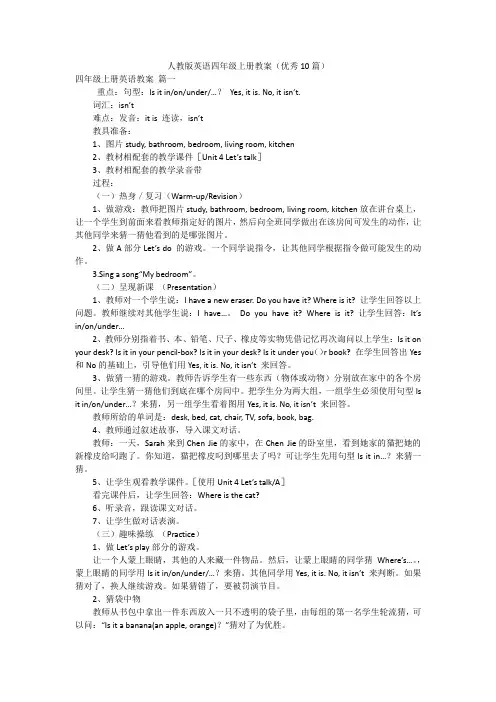
人教版英语四年级上册教案(优秀10篇)四年级上册英语教案篇一重点:句型:Is it in/on/under/…?Yes, it is. No, it isn’t.词汇:isn’t难点:发音:it is 连读,isn’t教具准备:1、图片study, bathroom, bedroom, living room, kitchen2、教材相配套的教学课件[Unit 4 Let’s talk]3、教材相配套的教学录音带过程:(一)热身/复习(Warm-up/Revision)1、做游戏:教师把图片study, bathroom, bedroom, living room, kitchen放在讲台桌上,让一个学生到前面来看教师指定好的图片,然后向全班同学做出在该房间可发生的动作,让其他同学来猜一猜他看到的是哪张图片。
2、做A部分Let’s do 的游戏。
一个同学说指令,让其他同学根据指令做可能发生的动作。
3.Sing a song“My bedroom”。
(二)呈现新课(Presentation)1、教师对一个学生说:I have a new eraser. Do you have it? Where is it? 让学生回答以上问题。
教师继续对其他学生说:I have…。
Do you have it? Where is it? 让学生回答:It’s in/on/under…2、教师分别指着书、本、铅笔、尺子、橡皮等实物凭借记忆再次询问以上学生:Is it on your desk? Is it in your pencil-box? Is it in your desk? Is it under you()r book? 在学生回答出Yes 和No的基础上,引导他们用Yes, it is. No, it isn’t 来回答。
3、做猜一猜的游戏。
教师告诉学生有一些东西(物体或动物)分别放在家中的各个房间里。
人教版四年级上册英语教案15篇

人教版四年级上册英语教案15篇(经典版)编制人:__________________审核人:__________________审批人:__________________编制单位:__________________编制时间:____年____月____日序言下载提示:该文档是本店铺精心编制而成的,希望大家下载后,能够帮助大家解决实际问题。
文档下载后可定制修改,请根据实际需要进行调整和使用,谢谢!并且,本店铺为大家提供各种类型的经典范文,如工作总结、工作计划、演讲致辞、规章制度、合同协议、条据文书、励志名言、好词好句、教学资料、其他范文等等,想了解不同范文格式和写法,敬请关注!Download tips: This document is carefully compiled by this editor. I hope that after you download it, it can help you solve practical problems. The document can be customized and modified after downloading, please adjust and use it according to actual needs, thank you!Moreover, our store provides various types of classic sample essays, such as work summaries, work plans, speeches, rules and regulations, contract agreements, policy documents, inspirational quotes, good words and sentences, teaching materials, other sample essays, and more. If you want to learn about different sample formats and writing methods, please stay tuned!人教版四年级上册英语教案15篇人教版四年级上册英语教案范文15篇教案可以帮助教师组织教学内容,包括选择教材、确定教学重点和难点,设计教学活动和任务等。
人教版小学四年级英语上册教案全册12
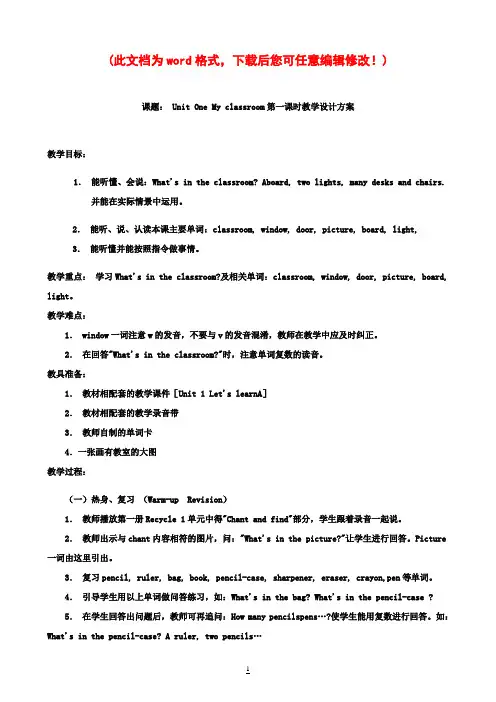
(此文档为word格式,下载后您可任意编辑修改!)课题: Unit One My classroom第一课时教学设计方案教学目标:1.能听懂、会说:What's in the classroom? Aboard, two lights, many desks and chairs.并能在实际情景中运用。
2.能听、说、认读本课主要单词:classroom, window, door, picture, board, light,3.能听懂并能按照指令做事情。
教学重点:学习What's in the classroom?及相关单词:classroom, window, door, picture, board, light。
教学难点:1. window一词注意w的发音,不要与v的发音混淆,教师在教学中应及时纠正。
2.在回答"What's in the classroom?"时,注意单词复数的读音。
教具准备:1.教材相配套的教学课件[Unit 1 Let's learnA]2.教材相配套的教学录音带3.教师自制的单词卡4.一张画有教室的大图教学过程:(一)热身、复习(Warm-up Revision)1.教师播放第一册Recycle 1单元中得"Chant and find"部分,学生跟着录音一起说。
2.教师出示与chant内容相符的图片,问:"What's in the picture?"让学生进行回答。
Picture 一词由这里引出。
3.复习pencil, ruler, bag, book, pencil-case, sharpener, eraser, crayon,pen等单词。
4.引导学生用以上单词做问答练习,如:What's in the bag? What's in the pencil-case ?5.在学生回答出问题后,教师可再追问:How many pencilspens…?使学生能用复数进行回答。
科普版四年级上册英语第十二课教案
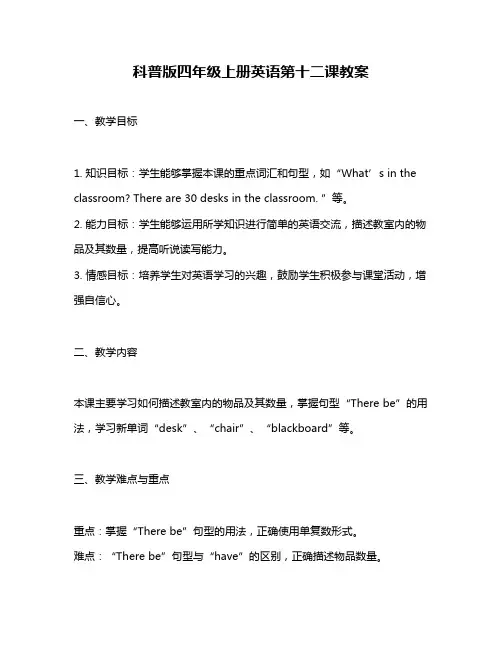
科普版四年级上册英语第十二课教案一、教学目标1. 知识目标:学生能够掌握本课的重点词汇和句型,如“What’s in the classroom? There are 30 desks in the classroom. ”等。
2. 能力目标:学生能够运用所学知识进行简单的英语交流,描述教室内的物品及其数量,提高听说读写能力。
3. 情感目标:培养学生对英语学习的兴趣,鼓励学生积极参与课堂活动,增强自信心。
二、教学内容本课主要学习如何描述教室内的物品及其数量,掌握句型“There be”的用法,学习新单词“desk”、“chair”、“blackboard”等。
三、教学难点与重点重点:掌握“There be”句型的用法,正确使用单复数形式。
难点:“There be”句型与“have”的区别,正确描述物品数量。
四、教具和多媒体资源1. 黑板2. 投影仪3. 教学软件4. 实物模型(如桌子、椅子、黑板)五、教学方法1. 激活学生的前知:通过问答方式,询问学生教室内的物品,复习已学过的单词和句型。
2. 教学策略:采用讲解、示范、小组讨论、游戏等多种教学方法,帮助学生理解并掌握本课内容。
3. 学生活动:组织学生进行角色扮演、对话练习等,提高学生的口语表达能力。
六、教学过程1. 导入:通过展示实物模型或图片,引导学生回忆已学过的单词和句型,激发学习兴趣。
2. 讲授新课:讲解新单词的发音和意思,示范正确的发音方法;讲解“There be”句型的用法和单复数形式,通过例句进行说明;组织学生进行小组讨论,探讨如何正确描述物品数量。
3. 巩固练习:设计多种形式的练习题,如填空、选择、翻译等,帮助学生巩固所学知识;组织学生进行角色扮演或对话练习,提高口语表达能力。
4. 归纳小结:对本节课所学内容进行总结,强调重点和难点;鼓励学生积极发言,分享学习心得。
四年级英语上册教案 Unit12 The football game 辽师大版(三起)
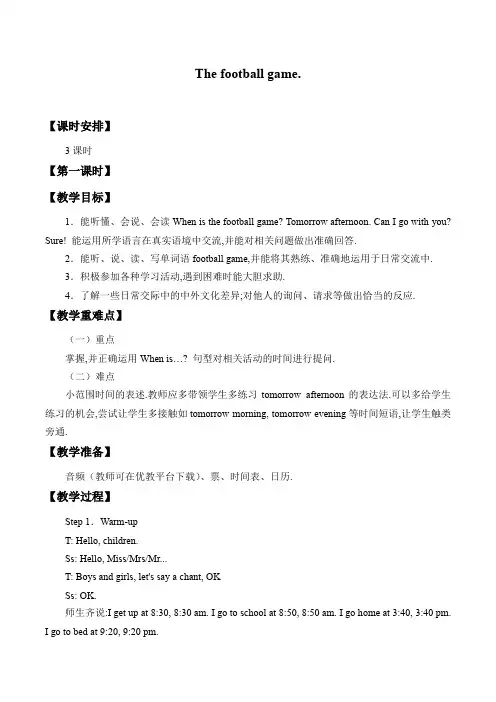
The football game.【课时安排】3课时【第一课时】【教学目标】1.能听懂、会说、会读When is the football game? Tomorrow afternoon. Can I go with you? Sure! 能运用所学语言在真实语境中交流,并能对相关问题做出准确回答.2.能听、说、读、写单词语football game,并能将其熟练、准确地运用于日常交流中.3.积极参加各种学习活动,遇到困难时能大胆求助.4.了解一些日常交际中的中外文化差异;对他人的询问、请求等做出恰当的反应.【教学重难点】(一)重点掌握,并正确运用When is…? 句型对相关活动的时间进行提问.(二)难点小范围时间的表述.教师应多带领学生多练习tomorrow afternoon的表达法.可以多给学生练习的机会,尝试让学生多接触如tomorrow morning, tomorrow evening等时间短语,让学生触类旁通.【教学准备】音频(教师可在优教平台下载)、票、时间表、日历.【教学过程】Step 1.Warm-upT: Hello, children.Ss: Hello, Miss/Mrs/Mr...T: Boys and girls, let's say a chant, OKSs: OK.师生齐说:I get up at 8:30, 8:30 am. I go to school at 8:50, 8:50 am. I go home at 3:40, 3:40 pm.I go to bed at 9:20, 9:20 pm.Step6.Homework1.完成活动用书中与本课内容有关的练习.2.听录音,熟读本课对话.3.与组内同学合作,创编新对话.【第二课时】【教学目标】1.能听、说、读、表演Let's act中的对话内容,此对话是对第一课时中对话内容的扩展和延伸,提供给学生更多类似语言环境中的交际语句.学生可以模仿对话与其他同学合作表演,进而熟练掌握,学习How is your...? Ready for it?2.能听懂、会说Let's chant 中的内容,学习picnic, movie 和Can I go with you?【教学重难点】(一)重点能够熟练运用Let's act部分的句型When is…?(二)难点与同学合作表演对话.教师可以先通过游戏大量操练新句子,再让学生表演.【教学准备】音频(教师可在优教平台下载)【教学过程】Step 1.Warm-up1.T: Good morning, boys and girls.Ss: Good morning, Miss/Mr/Mrs…T: How are you today?Ss: Fine, thank you, Miss/Mr…2.将学生分为四个小组,分别表演Listen and say部分的对话.Step 2.Presentation1.Let's actA.教师引导学生学习How is your ping-pong game? Ready for it? Not yet. 待学生理解后,独立阅读对话.B.教师引导学生听录音,跟读对话,分小组练习给对话配音,进而表演对话.表演过程中可适当拓展内容,加入一些日常用语.教师奖励表演得好的小组.2.Let's chant教师出示电影和野餐的图片讲解movie, picnic,让学生通过chant中上下文的联系理解句子We'll be late.随后播放录音,学生边听录音边学习chant: What time is the picnic? It's 2:50. It's 2:50. Hurry! Hurry! Hurry! Or we'll be late. What time is the movie? It's 7:15. It's 7:15. Hurry! Hurry! Hurry! Or we'll be late.Step 3.Practice以下活动应由教师视情况灵活安排.活动1:扔色子游戏.教师将本课的句子和词编成几组,写在黑板上.请学生掷色子决定读哪一句,读对的给予奖励或给小组加分.这个游戏前,教师要带着学生充分朗读复习.活动2:传话游戏.教师将这节课对话中的生词句写在黑板上,选择其中的一句由每组的第一个学生传至最后一个,最后一个学生在黑板上指出这个句子.活动3:Let's chant.教师播放节奏感强的音乐,请学生在音乐的伴奏下有节奏感地读出chant,鼓励有能力的学生背诵chant,并配以动作.活动4:创编对话.教师可以用幻灯片、图片和实物提供一些场景,供学生选择创编对话,使学生在应用语言的过程中实现语言的拓展.2.学习成果评价Make up the sentences with the words.(1)the / what / is / time / party?(2)afternoon / 3:30 / this?(3)what / the / cartoon / is / time?(4)tomorrow / 7:45 / morning?答案:(1)What time is the party?(2)3:30 this afternoon.(3)What time is the cartoon?(4)7:45 tomorrow morning.Step6: Homework1.完成活动用书中的相关练习.2.明录音,跟读Let's act部分的对话.3.如果后和小组同学运用本课核心语言,联系生活实际,创设情景自编对话.4.给爸爸妈妈说本单元的chant.【第三课时】【教学目标】1.学习字母Rr的发音,能认读例词rabbit,ruler, red.2.能够在图片的帮助下,运用所学的知识读懂本单元的英语小故事,并将其补充完整.了解What's wrong?的含义.3.对所学内容能主动复习和归纳.【教学重难点】(一)重点字母Rr的发音;培养学生自主阅读的兴趣和能力.(二)难点了解What's wrong? 的含义.教师可以创设几个情境,让学生在情境中整体感知和理解这句话的含义.【教学准备】音频(教师可在优教平台下载)、字母Rr的卡片、例词rabbit/ruler/red的卡片,准备几组对话表演.【教学过程】Step 1.Warm-up1.T: Hello, boys and girls. How are you?Ss: Fine, thank you.2.请几组学生展示自己课后创编的新对话.教师给于鼓励,以激发学生学英语的热情.Step 2.Presentation1.Listen and readA.教师出示字母Rr的卡片,请学生认读.并有韵律地领学生大声说Rr /r/ /r/ /r/. 使学生很快记住Rr的发音.B.请学生听录音机并跟读例词rabbit, ruler, red,出示例词卡片,请学生认读.Step6.Homework1.完成活动用书中的练习.2.听录音,跟读本单元的对话.3.和小组成员表演Read and say部分的小故事.。
冀教版四年级英语上册教案 (Lesson12)
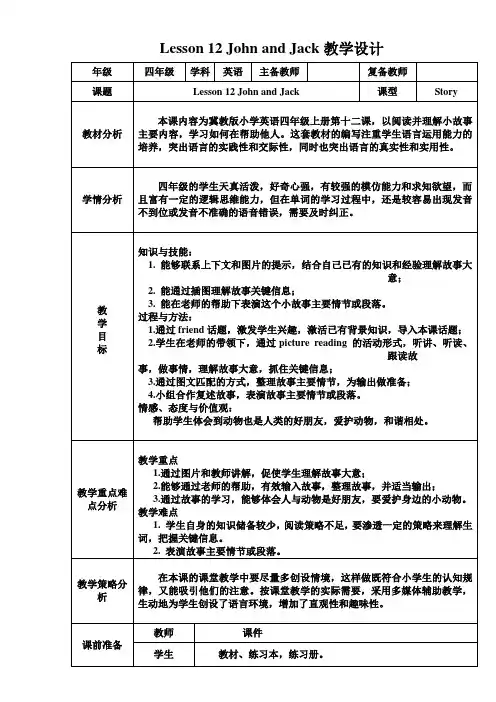
书
设
计
Lesson 12 John and Jack
Story Time
John---Jack---friends
教
学
反
思
在教授小故事的时候一定要给同学们创设情境,练习与我们生活息息相关的词汇和语句,在教授学生的时候还要注意纠正学生的语音语调,让学生热爱英语,乐于完成小故事的阅读和表演。
学生猜测并认识主人公。
学生跟随小故事的走向回答问题。
S:Brush my teeth.
S: Have breakfast.
学生跟随老师的思路回答问题。
S:I see the grass.
S: I see a ball.
在轻松的聊天氛围中开始本课的学习,为新知的学习做好准备,架设新旧知识桥梁。
揭示故事主人公,设疑激趣
学生自己谈谈与动物和谐相处的经历。
使学生对故事的理解难度降低,理解程度加深,激发学习兴趣,建立自信。教师在这个过程中也能渗透一些阅读策略。
培养学生的合作学习能力,通过小组自愿选择段落朗读、表演故事,提高学生继续阅读的积极性。
通过阅读故事,帮助学生体会到动物是人类的朋友,我们要爱护身边的动物,我们应与动物和谐相处,情感渗透,升华主题。
B. Picture 5,6,7,8
T:Look at picture 5. What do you see? What do they play?
出示图5,讨论图上所看到的东西,引导学生一起讲故事。
出示图6,比较两幅图的不同,猜测故事的发展。
S:Ihave a friend. We read a book. We do our homework.
通过阅读故事帮助学生体会到动物是人类的朋友我们要爱护身边的动物我们应与动物和谐相处情感渗透升华主lesson12johnjackstorytimejohnjackfriends在教授小故事的时候一定要给同学们创设情境练习与我们生活息息相关的词汇和语句在教授学生的时候还要注意纠正学生的语音语调让学生热爱英语乐于完成小故事的阅读和表演
四年级上册英语教学设计- Unit 12 Peter can jump high 第二课时 湘少版(
四年级上册英语教学设计- Unit 12 Peter can jump high 第二课时湘少版(三起)一、教学背景•学校:某某小学•年级:四年级•学科:英语•教材:湘少版(三起)英语四年级上册Unit 12 Peter can jump high第二课时•教学目标:1.能够听、说、认读句型:Peter can jump high.2.能够运用句型表达自己的能力。
3.能够参与小组活动与同伴互相展示自己的能力以及读本课课文。
4.培养学生自信、勇敢、团队意识和合作精神。
•教学重点:能够听、说、认读句型:Peter can jump high.二、教学内容及教法1. 教学内容1.本课词汇:jump,high2.本课句型:Peter can jump high.2. 教法认识英文字母与单词识记,情景教学引发学习热情,在听力、口语、阅读、写作等方面全面提高学生英语综合素养,不断降低对语言的抵触心理。
三、教学过程1. 热身活动•小组自由活动,展示自己的运动能力:贴标签、拿球、绕圈、跑步等。
•教师逐一点评学生的表现,给学生起一个学生个性化运动昵称,并在班级公示中标注每个学生的运动得分,激励学生积极参与。
2. 课堂讲解活动1.导入新词汇教师通过图片和视频介绍jump和high两个词汇的意思。
2.录音听力教师播放录音,学生跟读,并模仿录音。
3.读课文学生分组读课文,并回答问题:•What can Peter do?•Can Peter jump high?•What about you? Can you jump high?4.模仿句型说能力学生模仿句型说出自己的能力,例如:•I can jump high.•I can run fast.•I can swim well.•I can draw pictures.3. 教学总结及作业布置1.学生小组展示学生进行小组展示,展示自己的运动能力,展示自己模仿句型说的句子。
四年级上册英语教案-Unit 12 Peter can jump high. 课时1 湘少版(三起)
四年级上册英语教案-Unit 12 Peter can jump high 课时1教学目标:1.学习运动动词的表达方式2.掌握情态动词can的用法3.能够正确运用运动动词和情态动词进行句型表达教学重点:1.运动动词的表达方式2.情态动词can的用法教学难点:情态动词can的用法教学准备:1.教材2.PPT3.具有英语知识的小朋友教学过程:Step1:Warm-up1.Greeting:Good morning, boys and girls.2.Free talkT: Do you like sports?Ss: Yes, we like sports.T: What sports do you like?S1: I like football.S2: I like basketball.Step 2:Presentation1.T introduces sports vocabulary and shows pictures to help the students understand the meaning in English.2.T guides students to learn and memorize these phrases:run fast, jump high, swim well, climb trees, play basketball, play football, play volleyball, play tennis, skate, ride a bike3.T uses PPT slides to show these pictures together with the target phrases.Step 3:Practice1.T plays a game of。
科普版-英语-四年级上册-【全优解读】Lesson 12 教学案
【全优解读】Lesson 12 教学案REVISION复习1.Leading in情景导入亲爱的同学们,经过几个月的学习,你一定学到很多知识吧!赶快来一起复习以下吧!2.Focal guidance重点导航3.Let'S talk谈一谈(Q=Qiqi, E=Eve)Q: What's that in English? 那个用英语怎么说?E:It's a horse.它是一匹马。
Q: Who's on the horse?谁骑在马上?E:My uncle.我的叔叔。
Q: Is he a worker or a farmer?他是一位工人还是一位农民?E:He's a farmer.他是一位农民。
E:Can you see any sheep?你能看到一些绵羊吗?Q: Sheep?Where are they?绵羊?它们在哪儿?E: They' re near the house.它们在房子附近。
Q: Oh, yes.哦,是的。
E: How many sheep can you see? 你能看到多少只绵羊?Q:I can see fifteen.我能看到15只。
E: What's the time, please?请问几点了?Q:It's twelve o'clock.12点钟。
E:I have to go now.0 Goodbye.我现在不得不走了。
再见。
Q: Bye-bye.再见。
Uncle/'ʌŋkl/叔,伯,舅等对应词:aunt姑,姨,舅母等短语:my uncle我的叔叔uncle Wang王叔叔uncle John约翰叔叔例句:My uncle is a teacher.我的叔叔是一名老师。
farmer/’fa:mə/农民复数:farmers短语:a farmer -位农民例句:My father is a farmer.我的爸爸是一位农民。
陕旅版四年级上册英语教案 Lesson 12
Lesson12This is our new flat.教学目标 1.会说会用这些句子:My bedroom is small but nice.The living room is in the middle.It is big and bright.The bedrooms are clean and tidy.2.会说会用会写这些单词bedroom living room kitchen bathroom clean and tidy.重点难点会说会用这些句子:My bedroom is small but nice.The living room is in the middle.It is big and bright.The bedrooms are clean and tidy.教学准备 1.教师准备bedroom living room kitchen bathroom clean and tidy单词卡片。
2. 师生分别准备 bedroom living room kitchenbathroom 的图片。
3. 教师准备第 67页挂图。
教学过程一、热身(Warming up)师生对话引出话题:T:(to A)Whhere do you live?A: I live in/on… .T:(To B)Do you live in a village?B:Yes/No.T: (To all the students) Where do I live?展示第 67页挂图,喜悦地说。
I live in a new flat. It is very nice. Welcome to my new flat.Ss: Thank you.二、新课展示(New Presentation)学习课文词汇:老师展示准备的67页主图。
表现的很热情的样子,对学生们说介绍自己的new flat ,然后进行课文讲解。
- 1、下载文档前请自行甄别文档内容的完整性,平台不提供额外的编辑、内容补充、找答案等附加服务。
- 2、"仅部分预览"的文档,不可在线预览部分如存在完整性等问题,可反馈申请退款(可完整预览的文档不适用该条件!)。
- 3、如文档侵犯您的权益,请联系客服反馈,我们会尽快为您处理(人工客服工作时间:9:00-18:30)。
Module 1 NumbersUnit 1 seventeen, eighteen, nineteen, twenty!一、教学准备与分析1、教学内容第一模块第一单元活动1、2、3、2、教学目标技能与知识目标A基本要求基本能听懂、会说英文数字Numbers 13-20.基本能听懂、会说句型 This is + adj + one.B初步要求使学生初步理解和感知的句型Here’s的用法。
C巩固复习复习巩固颜色词汇yellow, white, purple, pink, red, green,blue.复习英语数字1---12复习歌曲“Rainbow”和“Ten little fingers”运用能力目的通过学习英文数字,使学生能够灵活运用所学到英文数字,对自己身边的数字进行正确英语的表达。
情感态度通过对本课的学习,让学生了解如何简单的用英语数字自己周围的事物,从中发现学习的规律,让学生从小培养爱学习、会学习的良好习惯。
3.教学重点英文数字Numbers 13-20.4.教学难点“thirteen”和“fifteen”发音5.教学准备教学卡片、教学用书、录音机、挂图、学生卡片、水彩笔二、教学程序1、热身复习(Warming-up)(1)新学期开始,向学生问好,并询问一下学生在假期都干了什么?T: Hello, the little fingers”并借此机会复习颜色以及英文数字1—12。
T: What colour is the pencilpenwindowdoor…?How many redgreenblue pencils…?2.任务呈现与课文导入(1)教师出示一组数字题1+1=?2+1=?3+1=?…,让学生接龙抢答,比一比,谁的反映最快?当进行到12+1=?教师将速度放慢,并请说出数字的同学到前台来给大家清楚的示范。
教师在此时可将单词卡贴在黑板上。
(2)教师准备了一个小见面会,——智力闯关游戏,想当大赢家吗?那么让我们赶快来学习这些英文数字吧!(3)听一听,说一说,你听到、看到、想到、知道了什么?3.课文呈现与操练(1)让学生看挂图听音,说一说发生了什么事?(2)听音跟读,画出听到的数字和句子,之后进行汇报。
(3) Touch game:教师请学生看黑板上的单词卡片并请出每组小代表,教师说英文数字,小代表们迅速找到数字,谁最快,谁是赢家。
(4) Bingo game: 教师请学生拿出水彩笔,教师说英文数字,学生用自己喜欢的颜色立刻相应的阿拉伯数字,之后教师在说带颜色的数字,如:Fifteen is blue.如果说的颜色和数字与学生写的一致,就迅速说Bingo!(5)结合学生用书活动三,让四人小组练习Thirteen is red.之后小组进行汇报。
(6)句子接龙:教师任意拿起教学用具,比如铅笔,说:This is a green pencil.在拿起另一个红色的说:This is a red one.还可用句型“Here is a red one.”(7)再次听音或观看VCD,鼓励学生模仿课文。
4.任务完成(1)智力大闯关教师出示四组英文数字的加法算式,让学生通过小组活动,以最快的速度描述和回答算式。
如:13+1=?(Thirteen and one is fourteen)之后请获胜组的同学将有资格进入下一关——猜猜他多大?(2)“猜猜他多大”教师给获胜的同学每人一张年龄卡,之后迅速转身告诉大家“I am fourteen.”在立刻转过身来,等七位同学都汇报完毕教师再任选一位同学发问“How old is :教师出示一些动物图片,请学生说出他们的名字。
(通过复习动物名称为下一步新知识教授作好铺垫。
)III. Presentation:1. 找几名学生到前面来,将刚才出示过的动物图片发给每个人一张,教师可作示范来问其中一名学生:”Have you got a tiger?”引导该学生说:Yes, I ’t.2. 请几名学生来猜猜他们每个人手里分别都有哪些图片。
如果有答对的教师马上给这名学生一张事先准备好的10分数字卡片.并且告诉他她:”You points.”并引导学生说出句子:”I’ ve got ten points.”板书句子。
3. 待全部猜完后每个人报出自己得到的分数,分数高的获胜,教师对他说:”You’re the winner.”板书单词winner。
4. 呈现课文:出示课文挂图,提问学生:Who is the winner? How many points .一、准备阶段:教学目标:情感目标:培养学生乐于助人的品质。
知识目标:学习句型Where’s West Lake Road, please? Go straight on. Turn left. Turn right. Where are you going?能力目标:培养学生问路、指路的能力。
教学重点;1.学习句型:Where’s …,please? Go straight on. Turn left. Turn right. Where are you going?2.掌握单词及词组: turn left turn rightexcuse me next to supermarket 教学难点:掌握表示地点和方位的词Ⅳ教学准备:挂图、录音机、磁带、图片、课文VCD二、教学过程:I. Warming upTPR活动。
教师边说边做:”Right .”学生跟着教师边做边说。
II. Revision:教师出示一些表示地点的图片如parkzooshopschool等,请学生抢答出单词。
III. Presentation:教师拿出公园的图片对学生说:”I’m going to the park this weekend. Where are you going this weekend?”学生说出自己的出行计划”I’m going to….”教师说:”Sam is going to Daming’s West Lake Road or East Lake Road? Let’s wactch the VCD.”学生观看课文VCD,找出答案并回答。
教师提问:”Sam asks the way to the policeman. How does ,同时在大屏幕上演示出课文中的路线图,教师边指图边讲解。
教授词组go straight onturn left turn right。
教师在大屏幕上出示几种路线图如:让学生说出路线。
学生打开书,跟录音朗读课文。
分角色朗读课文。
IV. Practice:1. 活动:问路。
让学生自己画一幅地图,上面有三条路,分别标有school zoo supermarket my and then turn left”。
2.活动:我迷路了。
教师准备一些路线图和要找的目的地单词卡。
教师将单词卡片发给一些学生,再将路线图发给另一部分学生,那单词卡片的学生作为迷路者来问路,如:”I’m lost. Where’s the park?”拿着路线图的学生帮助他们来指路。
V. Summary:教师:”Today we . Turn left. Turn right. ” We use them in the daily life.VI Homework请学生画出从家到学校的路线图并英语标注。
Unit 2 It’s at the station.一、准备阶段:教学目标:情感目标:培养学生乐于助人的品质。
知识目标:学习句子:The train is going updownpast the is going updownpast the uppaststation教学难点:掌握表示地点和方位的词教学准备:挂图、录音机、磁带、图片二、教学过程:I. Warming upTPR活动:教师或一名同学下口令turn left:请几名学生展示自己上节课画的路线图并向大家介绍从自己家到学校的路线,教师可把学生的路线图用投影放出来。
III. Presentation:1.教师准备一涨有课文背景图案的挂图,将小山、房子、学校、火车站分别贴在图上,并讲解单词hill和station。
2.出示火车图片并说:There’s a train from Beijing to our city.Where is the train going? 将火车贴在山上的位置,引导学生说出:“The train is going up the is going down the ”,图片交给学生请他们站在相应的位置。
将”train”的头饰交给另一名学生,并邀请一些学生乘坐火车。
老师请火车开动起来,并请其他同学一起说出火车经过了哪些地方。
2.完成P8练习3。
学生两人一组,学生A说出路线,学生B根据A的描述找到相应的地点。
学生A:Go straight on, turn left. It’s on your night. 学生B: Is it the supermarket? 学生A: No, it isn’t.3.活动:How can we go to Carrefour?学生以小组为单位讨论后设计出从学校到最近的一家Carrefour的路线图。
然后到前面来给全班学生讲解路线,选出最合理的一组获胜。
4. 学Chant。
教师首先播放一遍chant录音,请学生边看图边听。
学生找出生词,教师解释词义并指导学生读音。
再放录音,逐行停顿,学生边听边模仿学说。
听录音连贯跟读几次,鼓励学生加上动作。
5. 学唱歌曲。
教师首先播放一遍歌曲录音,请学生边歌词边听。
学生找出生词,教师解释词义并指导学生读音。
再放录音,逐行停顿,学生边听边学唱。
听录音连贯跟读几次,鼓励学生加上动作。
V. Summary:请学生总结今天所学的重点句子和单词。
VI Homework看P8图来描述火车所在位置。
Module 3 ActivitiesUnit 1 She’s writing a letter.教学目标1.Key sentences: This is my sister.She’s writing a letter.2.Vocabulary: writing a letter, taking pictures, talking to..教学重难点Aims 1, 2,3教学方法Listen, TPR, communication教学准备A recorder some cards wall chart教学过程教师活动学生活动ask Ss : “What can you see?”2.Play the tape , get the Ss write down all the numbers they the board: is are5.Point to the words and say the words.6.Then adds the following word on the board: ‘s7. Tell the Ss that this is the short form of “is", now the story. Warmer:1. Greetings.2. Ask and answer:Who is get them work in groups.Step1.Listen and repeat.1. Teach the new words:2. Call some Ss read and spell the words. writing a letter, taking pictures, talking tofriends, playing with a toy train..3. Practice the words more times by individual student or group.4. Have the Ss open their books, and look at the pictures in books, ask them: “Who are they?”(Daming, Lingling, Amy, Tom) “What are they doing?”(They are talking.) “What are they talking about?”学生问好Ss repeatSs look at the picture and answer the questions5. Play the tape, get the Ss listen.6. Play the tape again, pause it after each utterance, get the Ss repeat.7. The teacher read the text again, get the Ss repeat.8. Call two Ss act the roles in text.Step2. Listen and say.1. Play the tape, stop the tape after A finishes talking. Tell the Ss they are B, they can read B’s sentences.2. Work in pairs, one is A and one is B.Step3.AB bookSs listen aCall some Ss to repeat the sentence they to, read, do my on the board before the lesson).She’s writing a letter.She’s taking pictures,She’s talking toher friends,She is playing with a toy train.3. Tell the Ss that I’m going to say the pictures and they pairs. One say and one point.Step1. Look , listen and point.1. Get the Ss to open their books of Unit2, look at activity 1, then the teacher points to the pictures, ask the Ss: “What can yousee on the pictures?”Ss read the textSs look at the picture and answer the questions(The Ss tell the teacher what they see).3. Repeat the sentences.4. Now listen to the tape and point to pictures.Step2. Ask and answer1.Write some activities on the board, give the Ss some information about the activities.What are you doing?I’m listening to music.I’m watching TV.I’m reading a book.What is example first.3. Work in pairs.Step3.Listen and repeat. Pay attention to the stress.Step4.Listen and chant.Step5.Finish exercises of AB book.Homework: 1.Read the words and text of Unit1.2.Recite the words of M1.Ss reapeatSs listen and pointSs practiseSs repeatSay the chantModule 4 In the parkUnit1 What are they doing?教学目标1. Talking about activities in the park2.Key sentences: Present continuous:What are they doing?They are rowing a dragon boat.3.Vocabulary: let’s, get on, lots of, interesting, thing, look at, people, park, lake, row, boat, men, chess, drink, ..2.Revise the activities with the actions.(writing a letter,taking pictures,talking to friends,playing with a toy train..)3 The teacher ask the Ss: “Last lesson we learnt about the people in the park.(1)Look at the people in the park, what are they doing?(2)Look at the people on the lake,what are they doing?(3)Look at the men under the tree, what are they doing?(4)Look at the girls, what are they drinking?4. Call some Ss answer.(1)They are doing taijiquan.(2)They are rowing a dragon boat.(3)They are playing chess.(4)They are drinking soybean milk.Then point to the form on board, get the Ss say the activities on it ,and ask them “What are they doing?”Step1: Presentation1.The teacher show 4 pictures, .(2)They are rowing a dragon boat.(3)They are playing chess.(4)They are drinking soybean milk.2.Write the following sentences on board:What are they doing?They are rowing a dragon boatSs read the textSs look at the picture and answer the questions3.Teacher describe the pictures and get the Ss listen.4.Do more examples for Ss, make them understand the meaning.Step2.New lesson1.Have the Ss open their books, and listen to the tape, then find “What are they doing? They are rowing a dragon boat” in the text.2.After listen, check their answers.3.Show the cards on board , teach the new words:let’s, get on, lots of, interesting, thing, look at, people, park, lake, row, boat, men, chess, drink, text , and underline them.Ss reapeatSs listen and pointUnit 2 What is Amy doing?一、教学目标(Teaching aims)1、知识目标(Knowledges aims)(1)学习单词 : running jumping(2)学习如何询问他人正在干什么及其应答。
